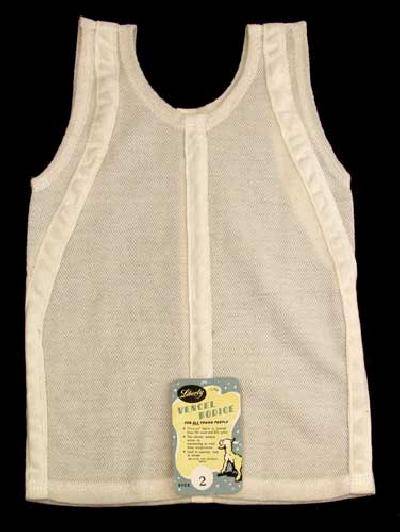
Underwear: The Liberty Bodice

Figure 1.--After World War II in Britain the liberty bodice was considered very old-fashioned and pretty much dropped out of use. But it persisted in a few places. We notice for instance an advertisement for a Vencel Liberty Bodice in 1958, "made for all young people" (presumably including both boys and girls). This is a "slip-on" model with no front or back closure that can simply be put on like a sleeveless
sweater. Rather than the traditional fleecy fabric associated with the earlier liberty bodice, this garment was made from a wool and nylon fabric known as Vencel.
|
|
The Liberty bodice were introduced about the turn of the 20th century to supplant various
tight-binding corset waists and other more restrictive undergarments. In Great Britain boys wore knee pants and long stockings (as in continental Europe and the United States) up until about 1914 (when the
World War I began). After this point, most English boys switched to wearing knee socks and no longer required a liberty bodice. Girls continued to wear them, however, up through World War II (they were often required as part of girls' school uniforms, which typically consisted of blouses and skirts worn with long black stockings and elasticized "knickers"--the British term for underpants). A few boys
wore liberty bodices in the period between the two wars for special dressy occasions when their mothers required them to wear long stockings, but by this time, the liberty bodice was considered very
much a girl's undergarment and was naturally hated by boys. After World War II in Britain the liberty bodice was considered very old-fashioned and pretty much dropped out of use. But it persisted in
a few places.
Early 20th Century (1900-20)
The Liberty bodice were introduced about the turn of the 20th century to supplant various
tight-binding corset waists and other more restrictive undergarments. In Great Britain boys wore knee pants and long stockings (as in continental Europe and the United States) up until about 1914 (when the
World War I began). After this point, most English boys switched to wearing knee socks and no longer required a liberty bodice.
Inter-War and War Years (1920-45)
Girls continued to wear Liberty bodices through World War II. They were often required as part of girls' school uniforms, which typically consisted of blouses and skirts worn with long black stockings and elasticized "knickers"--the British term for underpants). Boys rarely wore them. We know that because almost all available images of British boys during the inter-War era show them wearing kneesocks rather than long stockings. This is in sharp contrast to Germany where we see boys wearing both long stockings and kneesocks. A few British boys wore liberty bodices in the period between the two wars for special dressy occasions when their mothers required them to wear long stockings, but by this time, the liberty bodice was considered very much a girl's undergarment and was naturally hated by boys.
Post-War Years (1945- )
After World War II in Britain the liberty bodice was considered very old-fashioned and pretty much dropped out of use. But it persisted in a few places. We notice for instance an advertisement for a Vencel Liberty Bodice in 1958, "made for all young people" (presumably including both boys and girls). This is a "slip-on" model with no front or back closure that can simply be put on like a sleeveless
sweater. Rather than the traditional fleecy fabric associated with the earlier liberty bodice, this garment was made from a wool and nylon fabric known as Vencel.
HBC

Navigate the Boys' Historical Clothing Web Site:
[Return to the Main Liberty bodice page]
[Return to the Main underwear page]
[Introduction]
[Activities]
[Biographies]
[Chronology]
[Clothing styles]
[Countries]
[Bibliographies]
[Contributions]
[FAQs]
[Glossaries]
[Satellite sites]
[Tools]
[Boys' Clothing Home]
Created: 11:41 PM 9/5/2006
Last updated: 11:41 PM 9/5/2006


